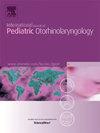Socioeconomic disparities in reconstructive pediatric microtia surgery
IF 1.2
4区 医学
Q3 OTORHINOLARYNGOLOGY
International journal of pediatric otorhinolaryngology
Pub Date : 2025-02-19
DOI:10.1016/j.ijporl.2025.112278
引用次数: 0
Abstract
Objective
To assess the association of race/ethnicity and education status on time to intervention and the total number of interventions in pediatric patients with microtia undergoing hearing intervention and external ear reconstruction.
Methods
A retrospective chart review was performed in pediatric patients diagnosed with congenital ear deformities evaluated by an otolaryngologist or audiologist from January 1, 2013 to December 1, 2021 at a large surgical institution. Variables analyzed included demographics, patient conditions, time to surgery, and number of surgeries. Statistical analysis included analysis of variance, chi-squared tests, and multivariate regression.
Results
Disparities were identified in reconstructive microtia repair, with non-White patients having an increased number of external ear reconstructive surgeries (p = 0.004), with Black patients average 2 external ear reconstructive surgeries, Hispanic patients 1.74 surgeries, while White patients averaged 0.812 surgeries. All non-White patients also demonstrated increased total number of surgeries (1.94 Asian, 2.57 Black, 2.11 Hispanic, 3.29 Other/Unknown, vs 1.23 White, p = 0.007) and total number of interventions (2.17 Asian, 2.71 Black, 2.37 Hispanic 3.43 Other/Unknown, vs 1.56 White, p = 0.02) as compared to White patients. In multivariate regression analysis, race was a significant factor influencing the number of reconstructive and overall surgeries, while the presence of aural atresia was the strongest predictor for requiring additional hearing surgery.
Conclusion
An increased number of interventions and surgeries were seen amongst non-White patients with microtia. Further investigation is warranted to understand the socioeconomic factors associated with pediatric microtia surgery.
求助全文
约1分钟内获得全文
求助全文
来源期刊
CiteScore
3.20
自引率
6.70%
发文量
276
审稿时长
62 days
期刊介绍:
The purpose of the International Journal of Pediatric Otorhinolaryngology is to concentrate and disseminate information concerning prevention, cure and care of otorhinolaryngological disorders in infants and children due to developmental, degenerative, infectious, neoplastic, traumatic, social, psychiatric and economic causes. The Journal provides a medium for clinical and basic contributions in all of the areas of pediatric otorhinolaryngology. This includes medical and surgical otology, bronchoesophagology, laryngology, rhinology, diseases of the head and neck, and disorders of communication, including voice, speech and language disorders.

 求助内容:
求助内容: 应助结果提醒方式:
应助结果提醒方式:


